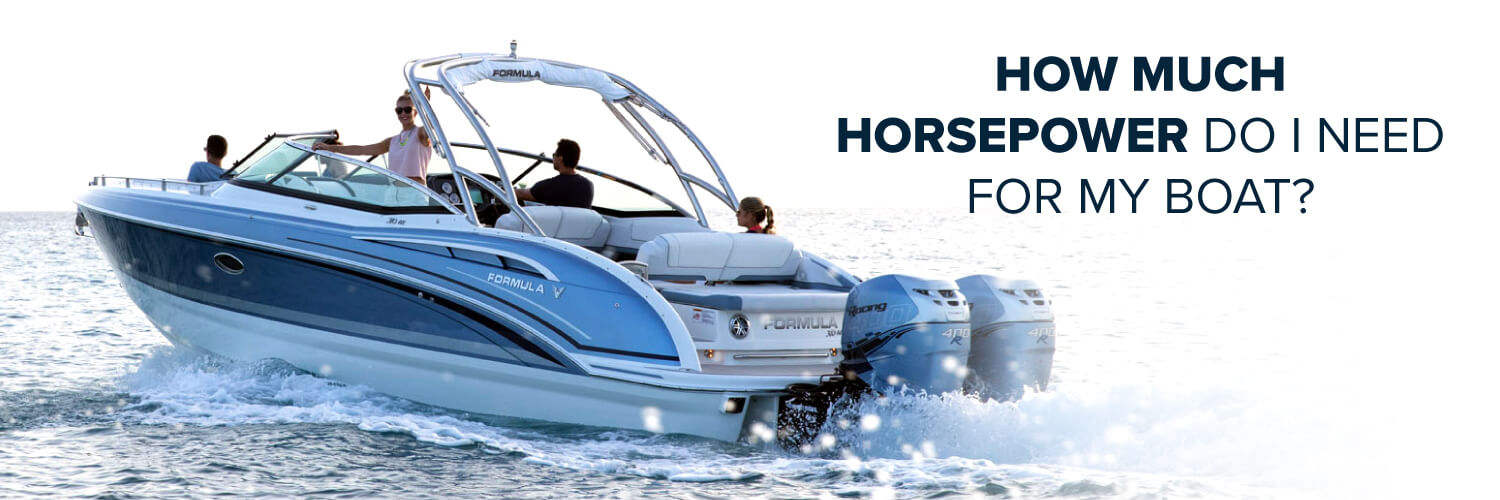
If you’ve been searching for a boat to purchase, or have reached the point at which you’d like to get a new engine, chances are you’ve asked the question, “How much horsepower do I need for my boat?” While the individual concerns may be different — wanting to make sure there’s enough horsepower or not too much horsepower — it’s a question many people who are interested in purchasing a new boat ask.
Sometimes, the follow-up question is, “Is it illegal to overpower a boat?” Whether you’ve been asking yourself one of these questions, or are just curious about how horsepower can affect the cost of fuel and insurance, we’ve gathered several pieces of information to educate you on horsepower. Through reading this information, you’ll be able to learn more about where it came from, how it’s calculated, how to determine the amount you need and the dangers that come with having too much.
What Is Boat Horsepower?
Horsepower is defined as a unit of power equal to 550 foot-pounds per second used to measure the power of an engine. Today, it applies to boat and auto engines, but its original use was to describe the power of a steam engine. In the late 1700s, a Scottish engineer named James Watt invented the first steam engine, which improved on a design pioneered by Thomas Newcomen in 1712. It was a big deal. This new steam engine could do the same amount of work as the former Newcomen engine, but used only one-quarter of the fuel.
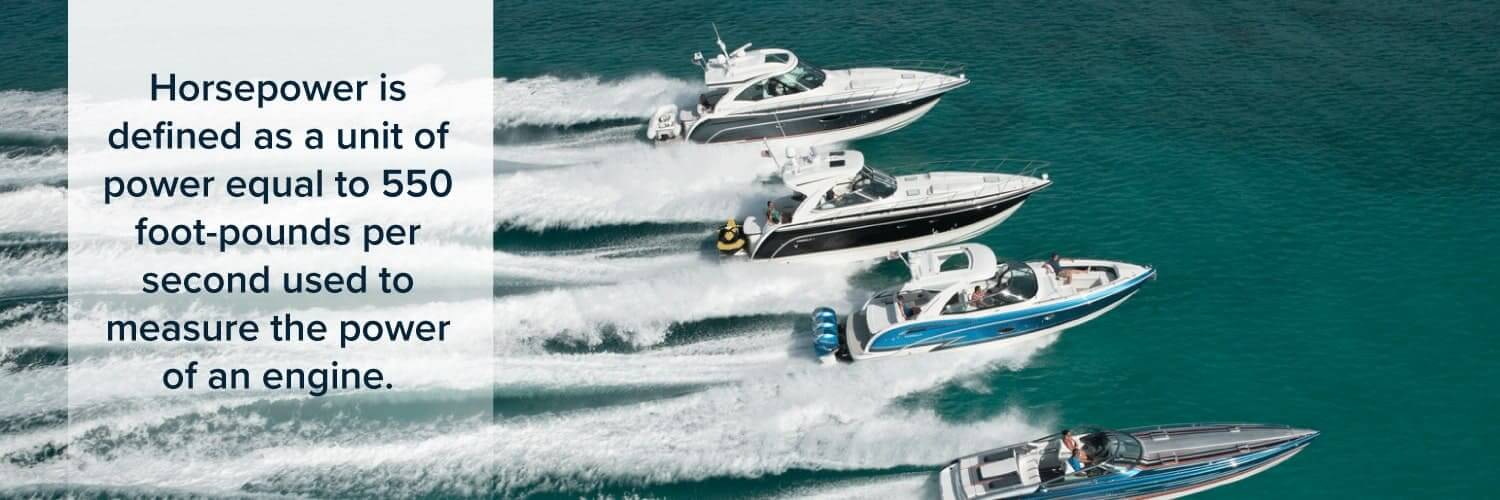
Unfortunately, comparing the steam engine to the Newcomen engine wasn’t effective marketing, as most of the population was still using horses for mechanical work. To market his new product to this audience, Watt knew he had to come up with a way to compare the work of horses to the work of his invention. Through his experiments, he determined one horse could do about 33,000 foot-pounds of work in one minute — meaning a horse could lift a 33,000-pound weight one foot in one minute. Therefore, he defined one horsepower as 33,000 foot-pounds of work per minute — or 550 foot-pounds per second.
There were a few flaws with this new measurement — the biggest being the assumption that a horse could continue to work at that consistent rate instead of tiring out. However, Watt didn’t let that fact bother him, and it didn’t bother his customers, either. Comparing the power of a horse to the power of a steam engine showed Watt’s steam engine could do the work of five horses, and it went on to become an integral part of the Industrial Revolution.
How Is Boat Horsepower Calculated?
The relevance of horsepower, the measurement of 550 foot-pounds per second, didn’t stop with the Industrial Revolution. The measurement of horsepower was converted into other units of measurement. For example, other experiments determined one horsepower equals 746 watts of energy. In other words, if you put a one-horsepower horse on a treadmill, it would be able to operate a generator producing 746 watts. Engineers also did calculations to relate horsepower to torque, which is especially important for boat engines.
Torque is easiest to explain through an example. Imagine you have a large socket wrench with a two-foot handle. You apply 50 pounds of force to that handle — when you do that, you’re applying a torque or turning force of a total of 100 pound-feet to the bold. Keep in mind, with that calculation, you could get the same result — 100 pound-feet of torque — by applying one pound of force to a socket wrench with a 100-foot handle, or by applying 100 pounds of force to a socket wrench with a one-foot handle.
In an engine, torque produces power — so being able to relate it to horsepower is critical. A device called a dynamometer applies a load on the engine and then measures the amount of power it produces to determine torque. Marine dynamometers are available, too — taking into consideration boat operation by simulating on-the-water operation. Once the torque has been determined, you’re able to convert torque to horsepower by multiplying torque by revolutions per minute (rpm) and dividing that product by 5,252. The divisor, 5,252, comes from a series of calculations that convert rpm to radians per second.
Through using a dynamometer, you’ll be able to see the horsepower versus rpm values for the engine, which is especially important for calculating peak horsepower. Engines will have a point in rpm at which the power available from the engine has reached its maximum. This is known as peak horsepower — it’s often documented as “___ HP at ____ rpm.”
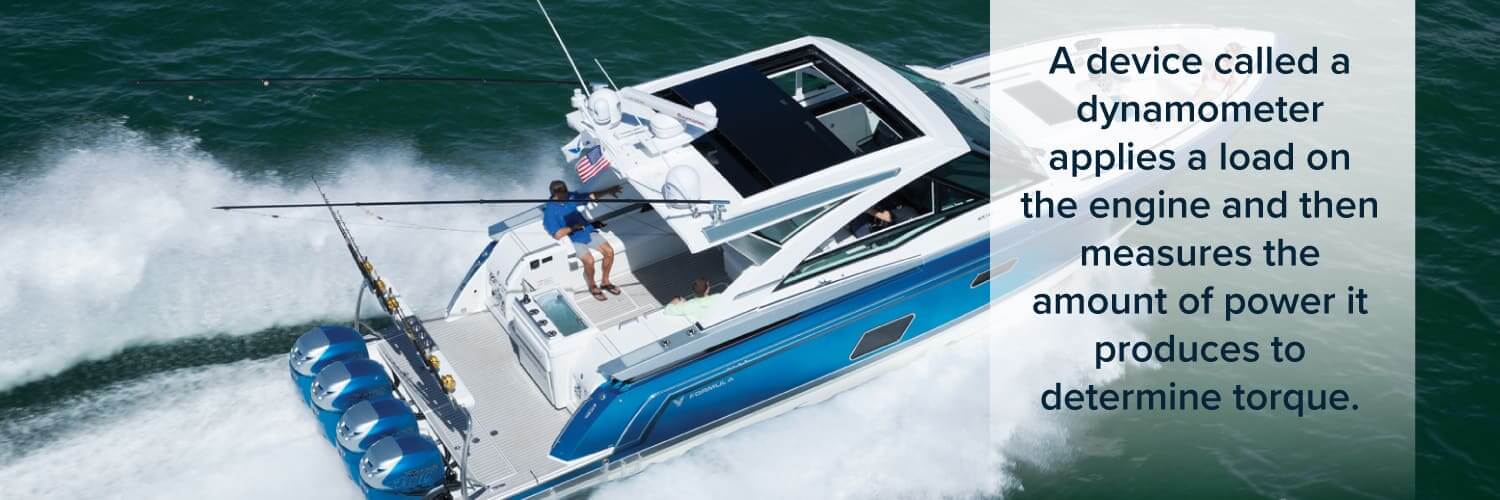
Determining How Much Horsepower You Need
Once you understand the history of horsepower and how that’s connected to the calculation we use today, it’s natural to wonder how much horsepower your boat needs. There are several factors to take into consideration when you’re determining how much horsepower you need — the manufacturer’s limits and recommendations, boat horsepower-to-weight ratio, fuel efficiency, use of the boat, number of people on the boat and an industry rule of thumb. Here are some things to consider in each of these areas to help you answer the question, “How much horsepower do I need for my boat?”
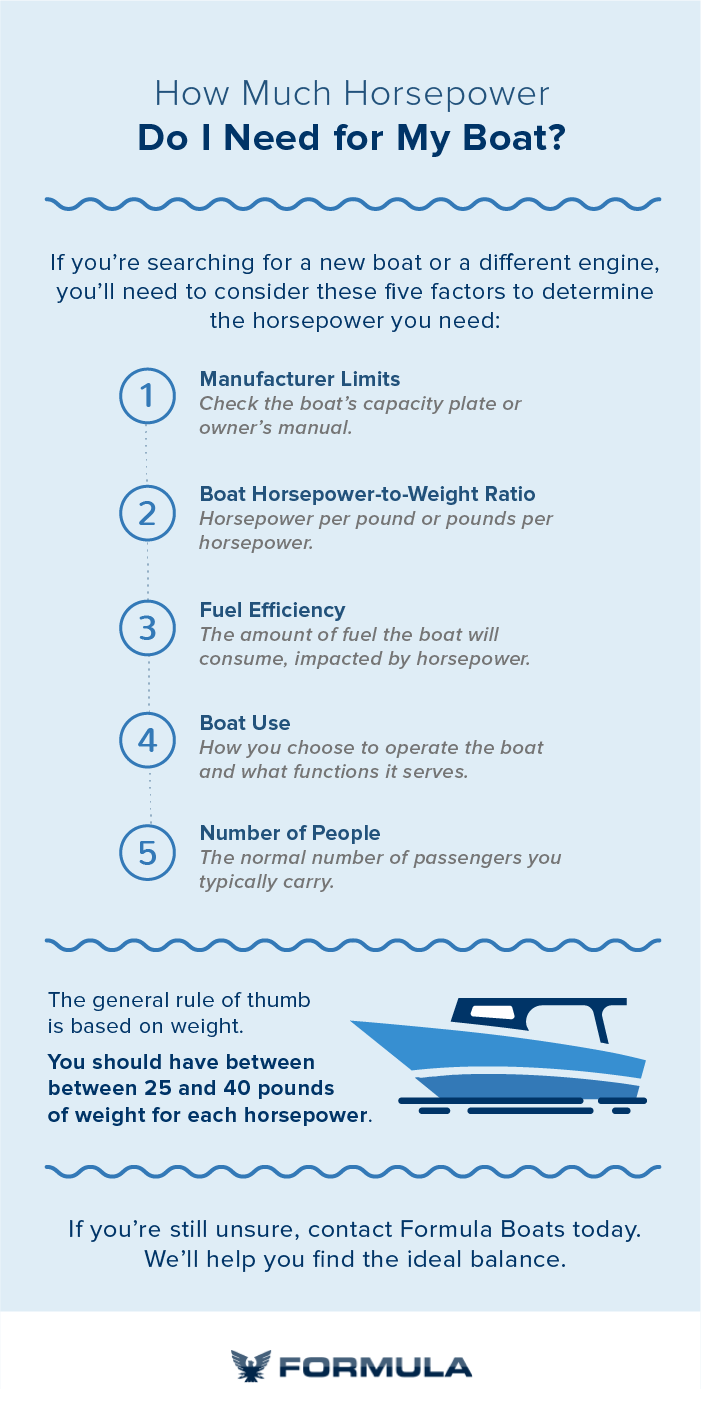
Manufacturer Limits
The easiest place to start is with the boat’s capacity plate — or owner’s manual. In addition to giving you a maximum for passengers and cargo, the manufacturer will also spell out the absolute maximum boat horsepower. If you have a boat that was built before 1972, came from overseas or was home-built, you may not have a capacity plate, but boat owner’s manuals are often available online. If not, you can always contact the boat’s manufacturer to inquire about their limits and recommendations for your particular boat model.
Boat Horsepower-to-Weight Ratio
When you’re trying to determine the amount of horsepower you need, it’s essential to consider the weight of the boat. The boat horsepower-to-weight ratio is simple to calculate and can be expressed in horsepower per pound or pounds per horsepower.
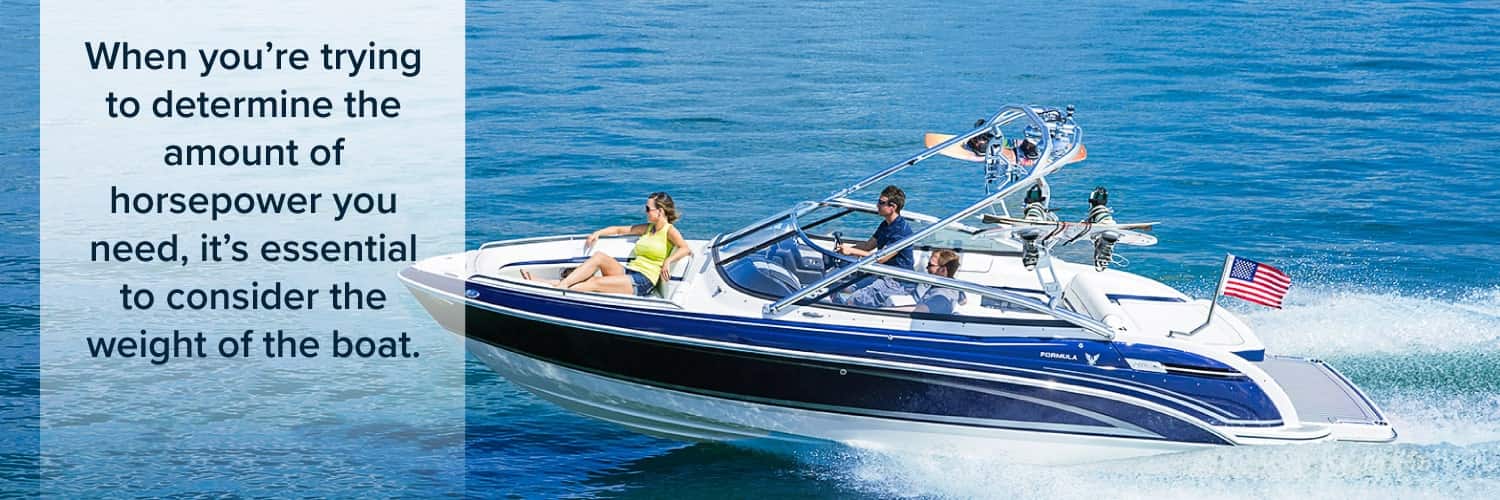
Let’s say, for example, your boat weighs 5,000 pounds, and it has a 300-horsepower engine. Taking 5,000 divided by 300 gives you a result of 16.6 pounds per horsepower. Doing the opposite calculation — taking 300 divided by 5,000 — gives you a result of 0.06 horsepower per pound. The lower the number, the faster your boat will go. Remember the boat horsepower-to-weight ratio once you’ve decided on horsepower and are matching outboard to boat size. While one or two outboards may give you the same horsepower result, keep in mind additional weight will accompany each additional outboard motor.
Fuel Efficiency
The amount of horsepower you choose will impact your fuel efficiency. However, just because you have a higher-horsepower engine does not necessarily mean you’re going to use more fuel. According to Boating magazine, running your gas engine between 3,000 and 3,500 rpm and your diesel engine at three-quarters throttle is the sweet spot for fuel efficiency. If you’re running a lower horsepower engine at full throttle all the time, it’s going to use more gas than a higher horsepower with less throttle. Keep this fact in mind as you consider what horsepower to choose.
For those who prefer exact calculations, Boating magazine has provided some calculations you can use to run some of the numbers. You’ll be calculating the gallons of fuel that are burned per hour (GPH). To do this, you need to know gasoline weighs approximately 6.1 pounds per gallon, while diesel weighs about 7.2 pounds per gallon. You also need to know a well maintained four-stroke gasoline engine is estimated to burn about 0.5 pounds of fuel per horsepower per hour, while a similar diesel engine is estimated to burn 0.4 pounds of fuel per hour.
The equation is GPH = (specific fuel consumption x HP)/fuel specific weight. For example, if you want to determine the fuel consumption for a 300-horsepower gasoline engine, you would calculate (0.50 x 300)/ 6.1, giving you a result of 24.5 gallons per hour.
Boat Use
As with most decisions related to boating, the use of the boat is always a factor. Are you using the boat just to cruise with friends and family? Or will you be pulling water skiers, wakeboarders and tubers? The addition of pulling someone behind the boat — and the additional weight of storing watersport accessories — increase the need for power and are often a reason to consider adding horsepower to your boat.
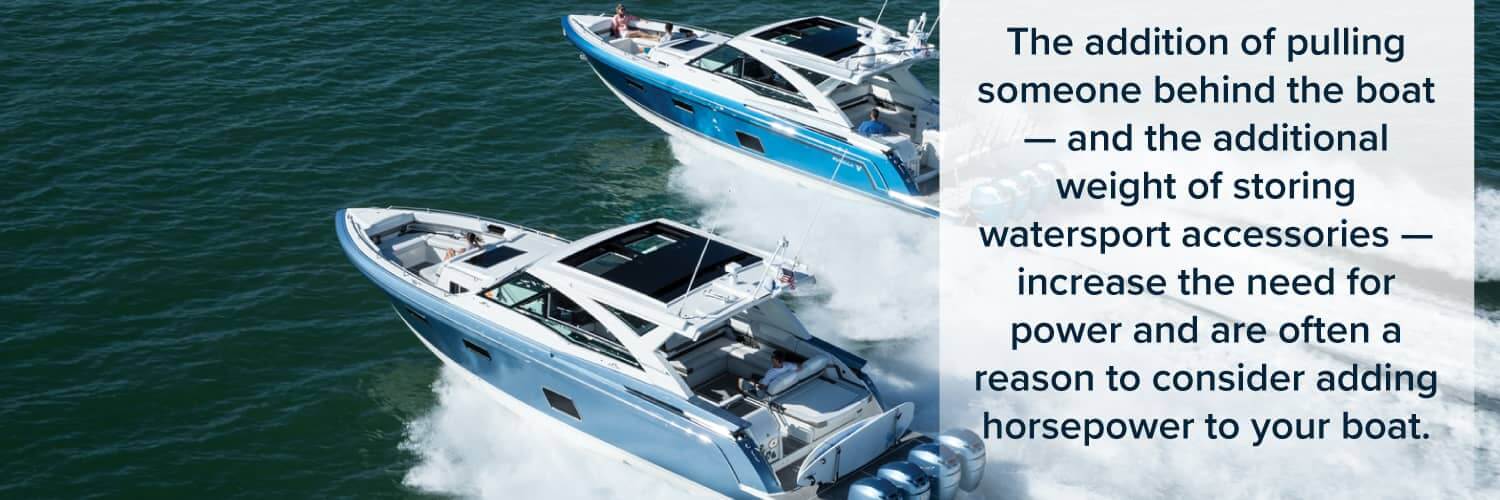
Number of People
Once you’ve considered the use of your boat, the next question to ask is what the normal number of passengers for your boat will be. If it’s usually just you and a friend or a spouse, that weight is different than if you enjoy boating with several of your family members and friends.
Rule of Thumb
If you’re the type of person who doesn’t need precise calculations — or just doesn’t want to be bothered with them — the Boat Trader blog offers a rule of thumb to use when determining the amount of horsepower for your boat. The rule of thumb is based on weight alone, and says you should have between 40 and 25 pounds of weight for each horsepower.
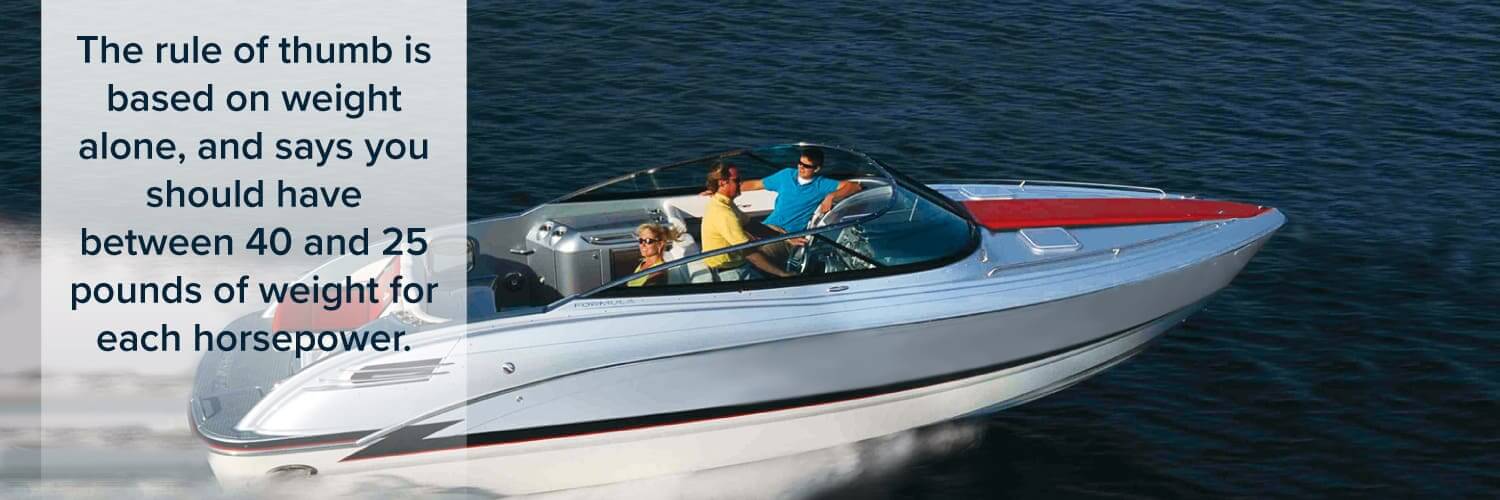
For example, a 5,000-pound boat could have an engine with between 125 and 200 horsepower. Yes, the range is wide, but that’s because boats have a variety of different designs and handle differently. While this rule of thumb can be a helpful way to get a ballpark range, it still requires some guesswork when it comes to considering your boat handling.
Federal Regulations
Is it illegal to overpower a boat? According to the federal government, yes. There are a few different ways you can define overpowering a boat. The horsepower capacity section of the Code of Federal Regulations contains its definition of overpowering a boat.
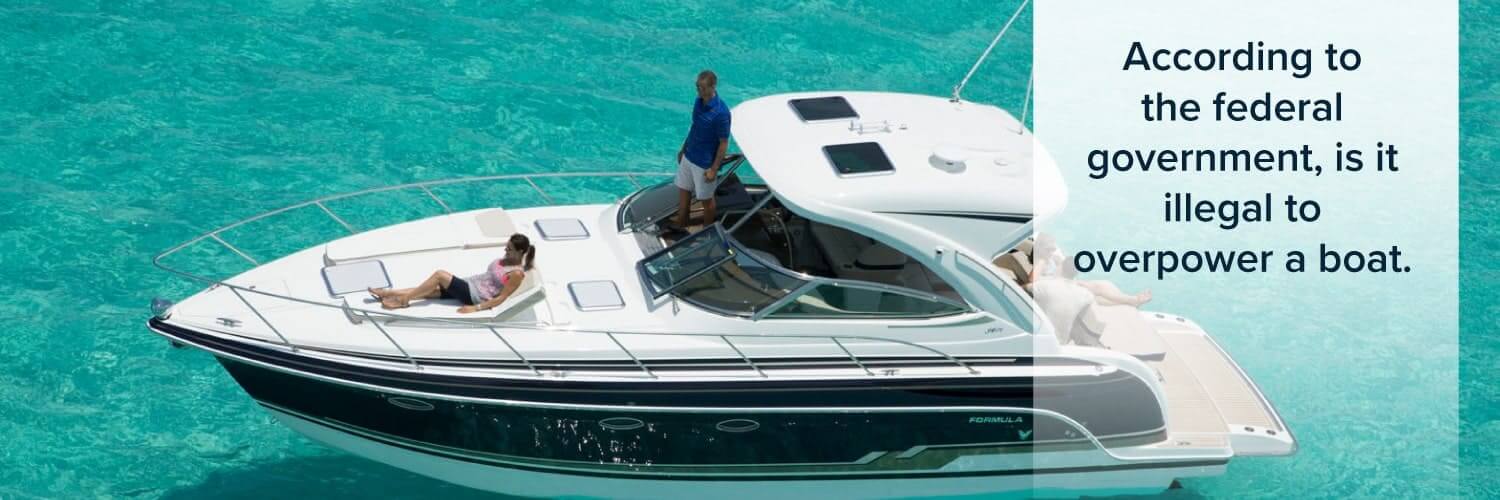
There are two different ways the federal government uses to determine the maximum horsepower for any given boat — one is a computation, and the other is a performance test. The way that is used depends on the boat. For the majority, the computation method is best to use. You multiply your boat length by the transom width. Then you take that number, which is known as the “factor,” and match it to a horsepower capacity according to the Code of Federal Regulations Table 183.53 — Outboard Boat Horsepower Capacity, shown below.
Don’t forget to adjust the result based on remote steering, transom height and boat bottom.
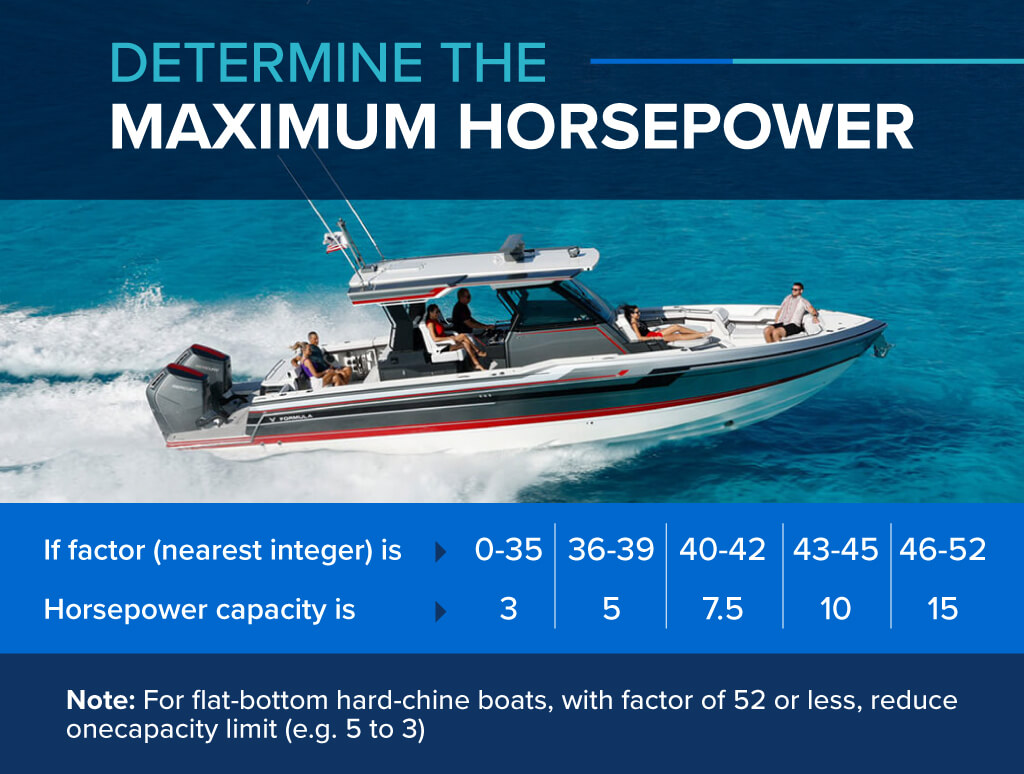
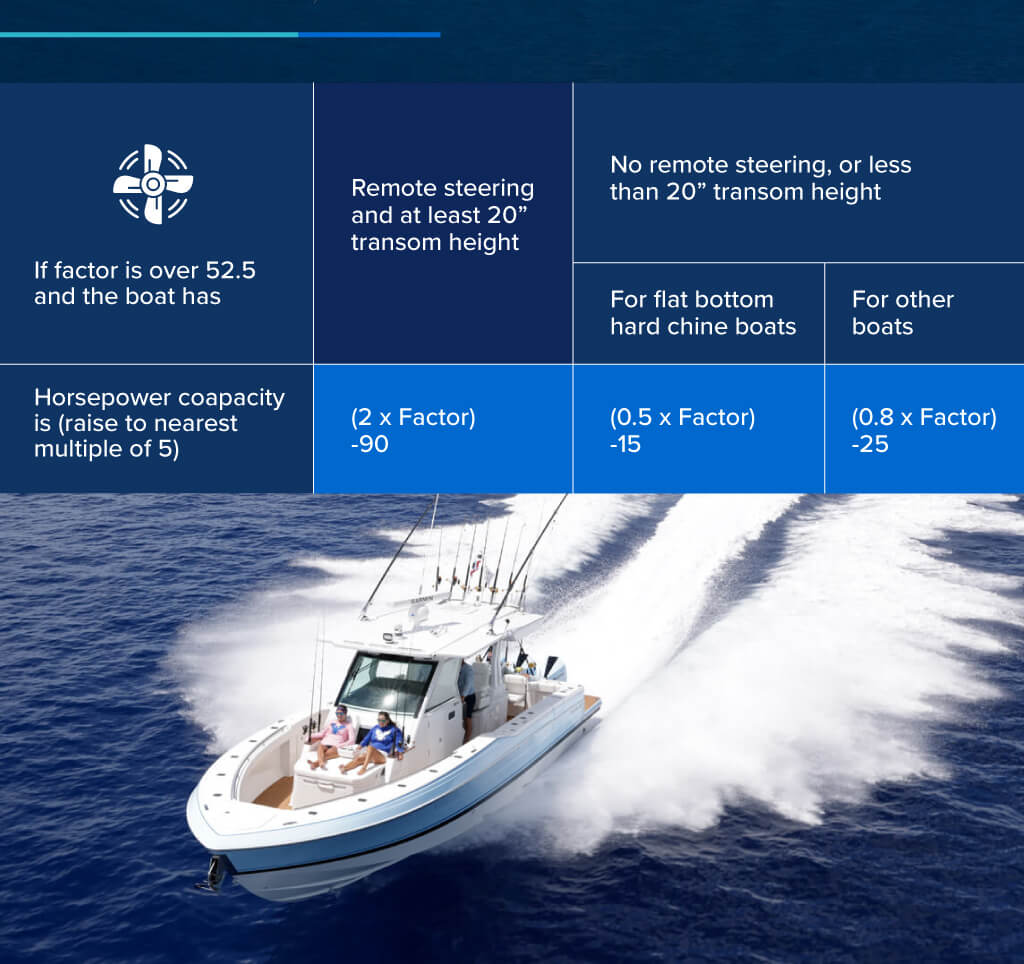
The performance test method is for boats that are 13 feet or less in length, have remote wheel steering, have a maximum capacity of no more than two persons and at least a 19-inch transom height — or at least a 19-inch motorwell height and at least a 15-inch transom height. Through this method, there are very specific instructions for boat preparation addressing everything from motor mounting to fuel tanks to ensure consistency. There are equally as specific instructions for the conditions in which you can perform this test.
The first part of the performance test is the quick-turn test. Setting the throttle at a low maneuvering speed and facing straight ahead, you then turn the wheel 180 degrees in half a second or less and hold it there. If you can complete the 90-degree turn without losing control of the boat or reducing the throttle, your boat has passed the test. Repeat, increasing the turn in speed until you can no longer pass the test, or you reach the maximum throttle. The maximum horsepower the boat can use while still completing this test is defined as the maximum horsepower capacity, unless it is more than 40 horsepower, in which case, the maximum horsepower capacity is capped at 40.
The good news is, these rules are in place for boat manufacturers, so assuming your boat’s manufacturer is following the federal regulations, you can consider the maximum horsepower capacity listed on your boat meets the federal regulation for its maximum horsepower.
Insurance Considerations
The amount of horsepower your boat has will influence your boat insurance, which is another fact to consider. There are three main areas of insurance the amount of horsepower you choose for your boat will affect — overall coverage, premium cost and type of policy.
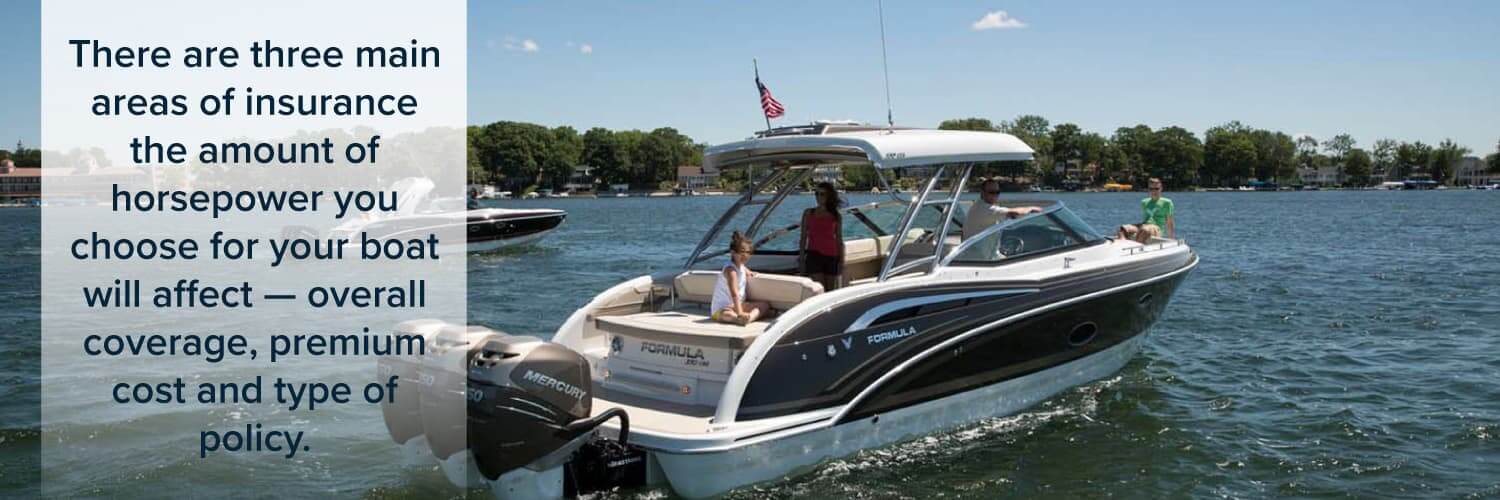
Overall Coverage
There is also a chance your insurance company will not cover a vessel that exceeds the boat manufacturer’s max horsepower. This is an extremely important factor, as it could affect your ability to get insurance coverage for your boat. If your boat is currently insured and you’re considering a motor upgrade, make sure you know your insurance company’s rules for horsepower limits. If you upgrade without abiding by these rules and notifying your insurance company, there’s a good chance they won’t cover any claim you file.
Premium Cost
While abiding by your insurance company’s rules for boat horsepower, it’s important to remember that doesn’t mean a change in horsepower won’t bring a change in your premium cost. As a rule of thumb, boats with higher horsepower will be more expensive to cover.
Type of Policy
In addition to solely considering the horsepower of the boat, the overall size of the vessel, which takes horsepower into account, may determine the type of boat insurance policy you need to get. For example, your homeowner’s or renter’s insurance policy will usually cover smaller powerboats with less than 25 horsepower. Boats that are larger and have more than 25 miles per hour horsepower almost always require a separate boat insurance policy.
Dangers of Overpowering Your Boat
Bigger and faster is not always better. Putting more horsepower behind your boat may seem like an innocent way to add some excitement to your boating experience, but it could cost you a significant amount of money in fines, lawsuits and damage to your boat. Here are a few examples of how your need for speed can get you in trouble when it comes to boat maximum horsepower.
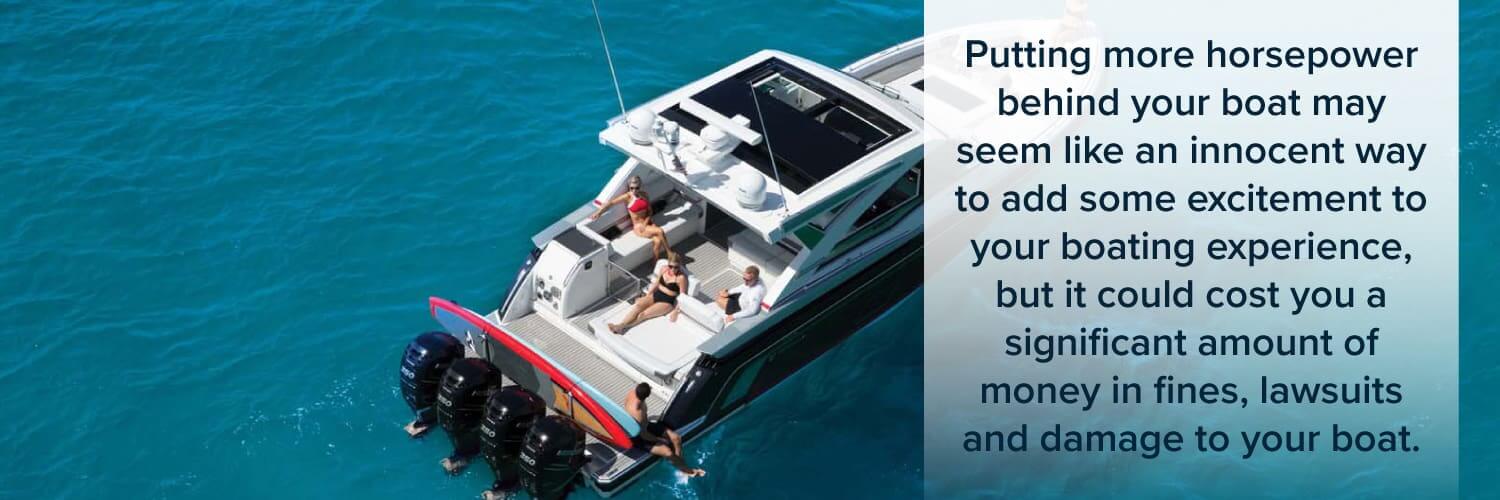
Breaking the Law
Is it illegal to overpower a boat? In some cases, yes. There are federal laws in place to ensure the appropriate horsepower limits are listed on all boats. State and local laws regarding overpowering your boat vary. Make sure you know the state and local laws for the areas in which you’ll be boating. Otherwise, your excess horsepower may be putting you at risk for fines and other consequences.
Accident Lawsuits
Even if your state and local laws don’t address overpowering your boat, you’re still putting yourself at risk in other ways. If you’re in an accident, the fact that your boat’s horsepower is above and beyond the manufacturer’s recommendations will be in the accident report. While you may not have fines because of breaking state and local laws, you are very susceptible to being found negligent and the victim of a lawsuit, especially in a case where there are damages.
Too Much Weight
In recent years, more horsepower hasn’t always meant more weight. However, it is still true in some cases, and that additional weight is another component of high horsepower that can be dangerous. For example, the additional weight can make a self-draining cockpit useless, leading to flooding problems.
Boat Damage
Even with additional horsepower that doesn’t add weight to the boat, the additional speed applies pressure that can cause significant damage to your boat. Every part of your boat, from the transom to the bow, was created to withstand a certain amount of pressure and stress. If you decide to ignore the boat’s maximum horsepower and overpower it, you’re exposing every part of your boat to pressure above and beyond what it was designed to endure, risking significant damage to the hull of your boat.
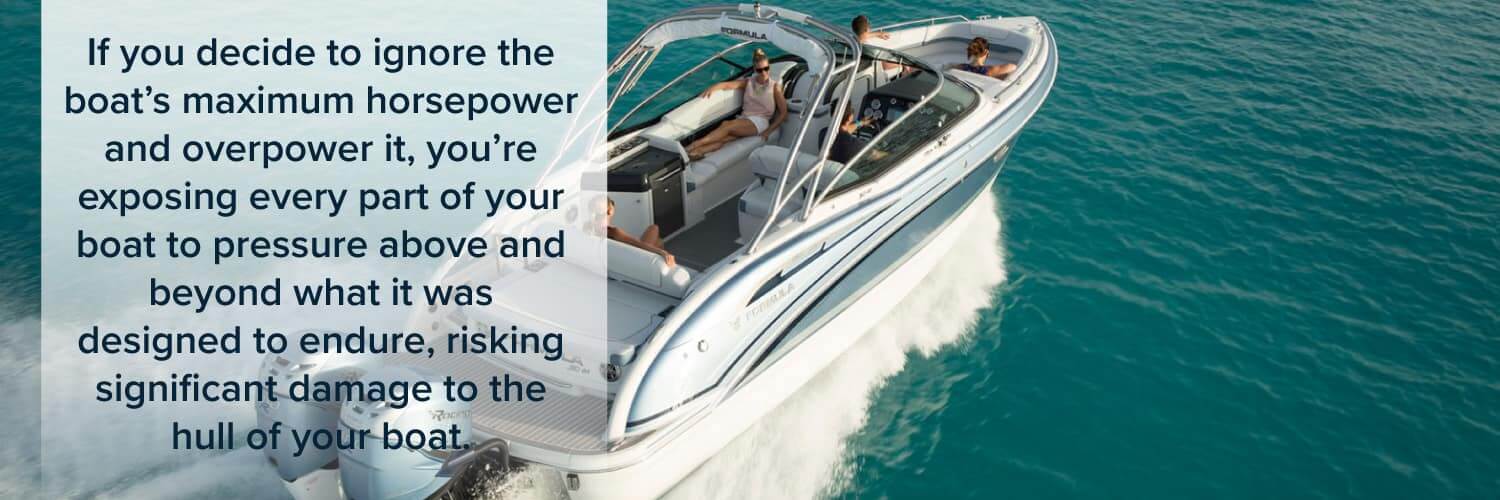
Finding a Boat With the Ideal Balance
As a boat manufacturer, at Formula Boats we know the balance of giving you the power and speed you want while making sure safety is a priority. If you’re considering purchasing a boat, our online boat builder gives you the opportunity to fully customize several different boat models with a few different horsepower options. You can be sure horsepower options for each boat model we provide are within the limits we believe maximize your performance while maintaining safety.
Discover a boat you like through our boat builder? We have dealers located throughout the country ready to help you find your boat. Get started by searching for the dealer location closest to you on our website.
Even though we narrow down the options, it can still be tough to choose the amount of horsepower that will give you performance based on boat weight and use, but also fuel efficiency. If you’re interested in one of our boat models, but are still wondering how much horsepower you need, we’re here to help — please don’t hesitate to contact us.
